Tomato sauce is one of my all-time favorites. A good homemade tomato sauce recipe complements many of your favorite easy dishes - think spaghetti, lasagna, or pizza. By making your own sauce at home, you can avoid many of the preservatives found in commercial products, plus you can tailor the taste to your liking.
The tomato sauce recipe presented here is the French cuisine version. It is one of the basic leading sauces, also known as the five mother sauces, taught in just about every culinary school in North America. There are many variations that can be created from this base recipe.
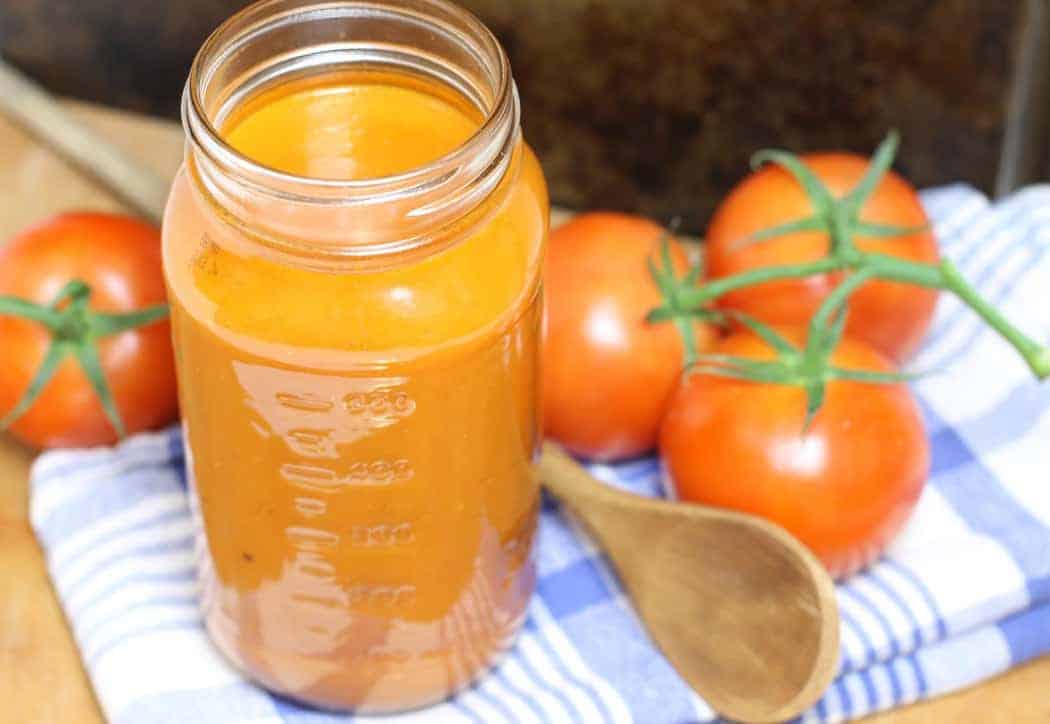
This post is part of the basic cooking skills series, which includes learning to cook the five mother sauces of French cuisine at home: Béchamel sauce, Velouté sauce, Espagnole sauce, Tomato sauce, and Hollandaise sauce.
This post contains affiliate links for which we may be compensated if a purchase is made through the links provided at no extra cost to you. For more information, please read our affiliate disclosure.
Why You Should Make Your Own Tomato Sauce
There are many reasons and benefits to making your own sauce at home. The most appealing one is that you avoid many of the preservatives commonly found in commercial products.
In most cases, homemade tomato sauce is also more nutrient dense and richer in vitamins and minerals as well. Sean from Diversivore does a great job explaining some of the differences between using homemade and store bought sauces in his Sausage and Eggplant Bucatini recipe.
The other obvious benefit is that you can tailor the taste to your liking. Do not like celery? Leave it out. Want more oomph? Just add extra garlic!
If you grow your own herbs or grow tomatoes at home, you can also make large batches of fresh tomato sauce with varying flavors, such as basil and tomato, or a garlicky marinara-style sauce. These homemade sauces can be frozen or canned and stored for future use.
I tend to make a big batch of tomato sauce around the end of the summer. This is great for the winter months when the price of tomatoes usually goes up.
By the way, if you have never grown your own tomatoes, you can always start saving tomato seeds and growing them yourself. It's a surprisingly easy and fun project to take up.
A Simple Homemade Tomato Sauce Recipe From Fresh Tomatoes
The key to a good quality and versatile tomato sauce is to keep the recipe fairly simple.
You will need:
- 3 cups chopped onions
- 3 cups chopped celery
- 4 cups fresh diced tomatoes or 2 cans diced tomatoes
- 3 cloves of garlic
- 1 tablespoon sugar
- 2 cups chicken stock or water
- 4 tablespoon tomato paste
- Fresh herbs such as basil and thyme
- 2 tablespoon clarified butter or oil
- Salt
- Pepper
- Bayleaf
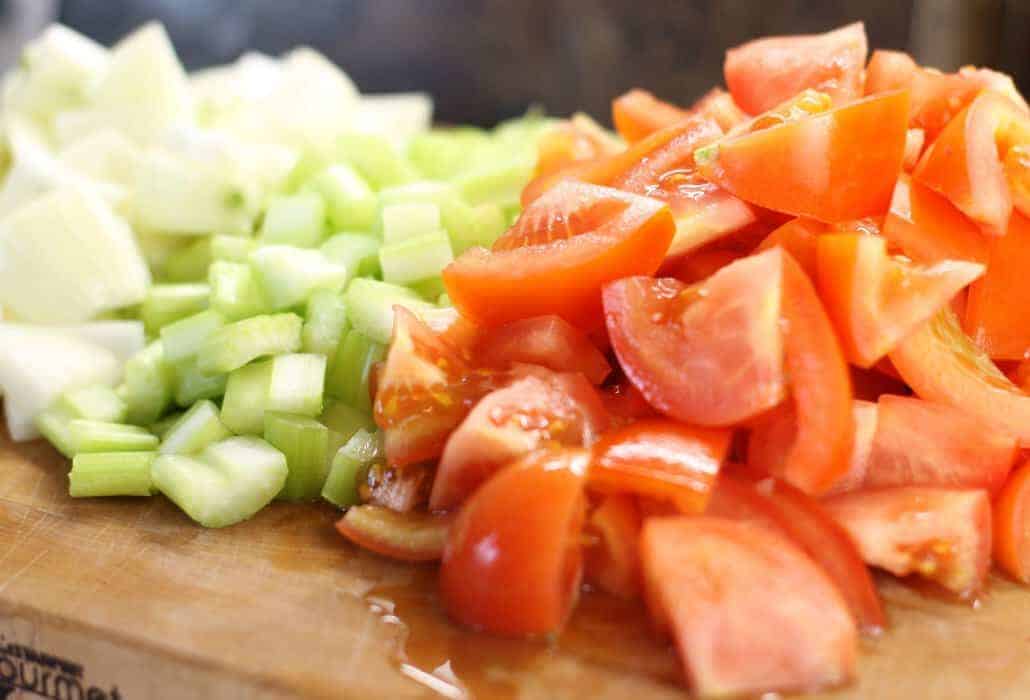
Tomato Sauce Instructions
Start by sautéing the onion, celery, and garlic cloves in the oil. Cook the vegetables over medium heat until the onions start to turn translucent. Avoid browning the vegetables at this point if you can. This is called sweating the vegetables and releases some moisture before adding the tomatoes.
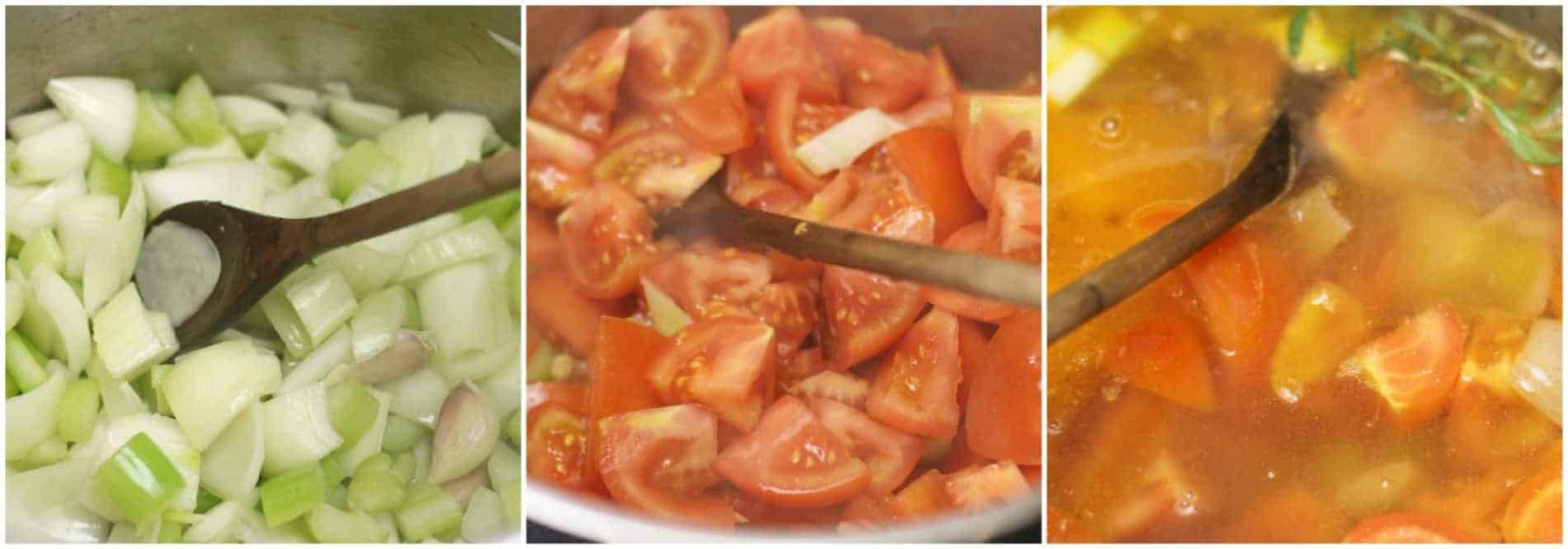
Add the diced tomatoes, herbs, spices, and chicken stock. Bring the pot to boil and then reduce to a low simmer. Cover the pot and let the tomato sauce cook for an hour.
Periodically check the sauce and stir it to prevent any tomato pulp from sticking to the bottom of the pot and scorching.
Once the tomato sauce has simmered for about an hour, all the vegetables should be nice and soft. Use an immersion blender or a food mill to purée the sauce.
You can also use a standard Vitamix or Nutribullet blender, but be careful working with the hot sauce. It will expand when mixed and can pop the lid, potentially burning you. Wait for the sauce to cool down a bit, and even then fill the blender only halfway.
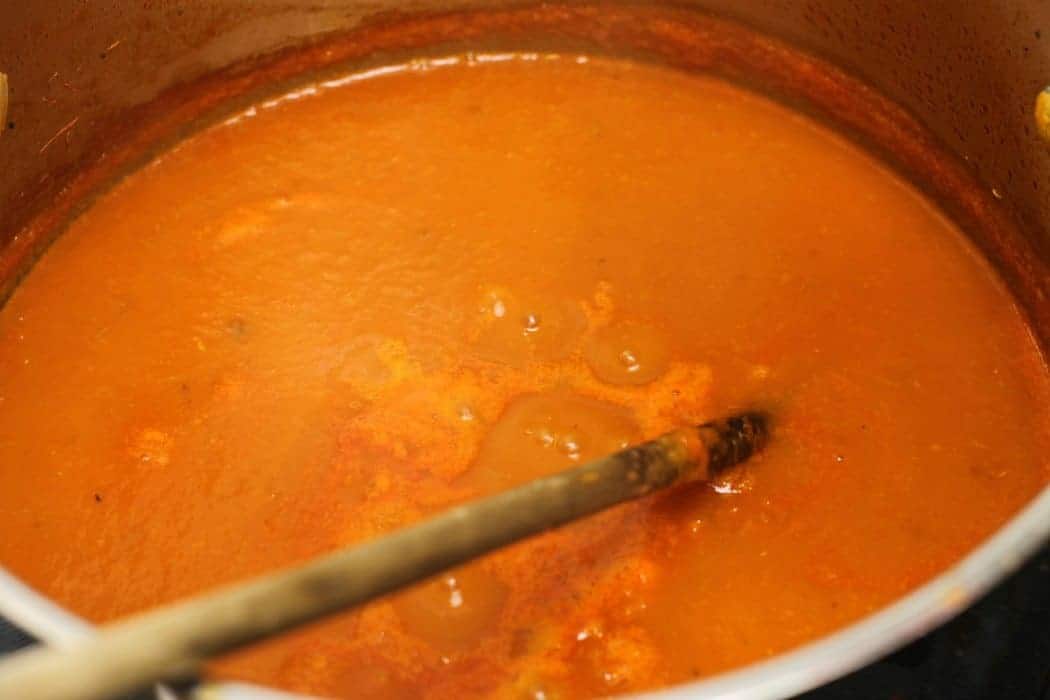
If the tomato sauce is very runny and watery after puréeing, continue simmering the sauce to reduce it and cook off some of the water. As it cooks, it will naturally thicken. The type of tomatoes used, their freshness, and quality all play a role in how watery the tomato sauce may turn out.
You can always adjust the thickness of the sauce by adding tomato paste or additional diced fresh or canned tomatoes. If you add more tomatoes to the sauce, you will need to cook the sauce longer and then purée it again.
Here is the final tomato sauce strained into he glass jar, ready to be stored or canned.
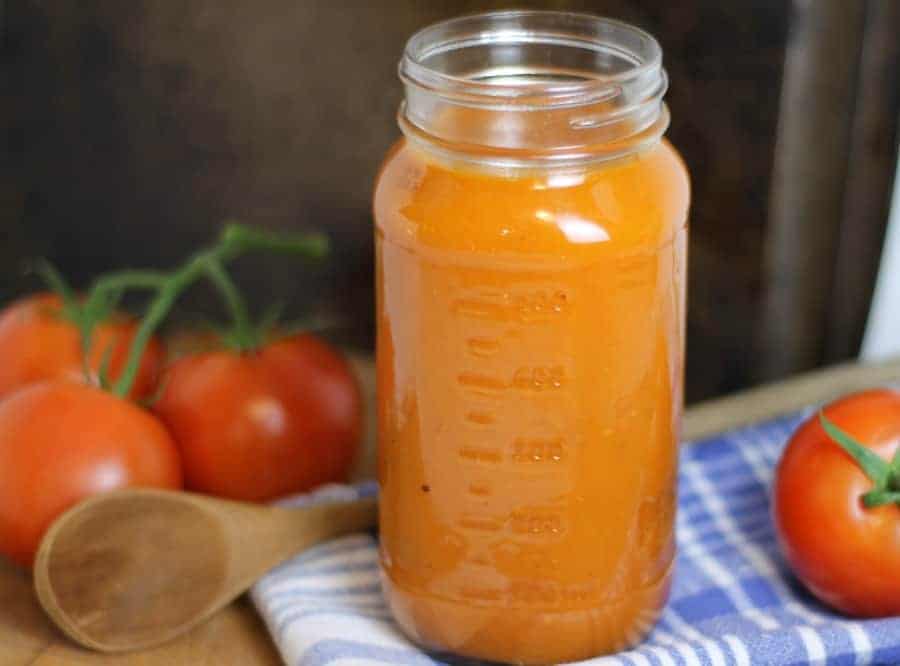
Note that homemade tomato sauce is usually more orange-y in color than store bought sauce, and that is normal. If that bothers you, you can add red color by adding more tomato paste or other tomato concentrate.
Tomato Sauce Variations
As mentioned above, the tomato sauce recipe presented here is one of the five mother sauces of French cuisine. Those were created as a base recipe, which then can be built upon and modified to suit your own tastes.
You can create a Primavera-style pasta sauce by adding more vegetables. You can season your tomato sauce with basil, garlic, or even chili for a spicy version. As the cook in the kitchen, you have the ultimate say in creating the flavor profile you like.
Some other common derivatives and variations of the base french tomato sauce recipe are:
- Creole Sauce: To create this variation, add finely diced onion, sliced celery, diced green pepper, okra, green olives, and hot pepper sauce to the tomato base.
- Spanish Sauce: Add diced onion, celery, sweet peppers, garlic, sliced mushrooms, tomato concassée (roughly chopped tomatoes), and chilies to the tomato base.
- Provencal Sauce: Not technically a derivative, but part of the tomato sauce family, Provencal is made by sautéing tomato concassée (roughly chopped tomatoes) with garlic and shallots. It is then seasoned with herbs, salt, and pepper.
- Bolognese Sauce: Also not technically a derivative, bolognese sauce is made (traditionally) by cooking finely diced beef (modern recipes use ground beef) with onions, celery, herbs, and garlic before adding tomato sauce.
Made the recipe? Comment & Rate it below, then take a picture and tag me on Facebook. For more homemade cooking from scratch recipes, follow me on Facebook & Pinterest.
Recipe
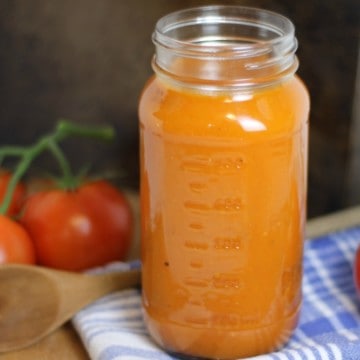
Homemade Tomato Sauce From Scratch
Ingredients
- 3 cups onions chopped
- 3 cups celery chopped
- 4 cups fresh tomatoes diced or 2 cans diced tomatoes
- 3 cloves of garlic
- 1 tablespoon sugar
- 2 cups chicken stock or water
- 4 tablespoon Tomato paste
- Fresh herbs such as basil and thyme
- 2 tablespoon clarified butter or oil
- Salt
- Pepper
- Bayleaf
Instructions
- Chop all the vegetables, and gather the rest of the ingredients.
- Saute the onions, celery and garlic, until the onions turn translucent.
- Add the tomatoes, spices, herbs and stock. Simmer the tomato sauce for atleast an hour on medium low.
- Puree the sauce completely using an immersion blender or other mixer. If the sauce is to thin at this point, keep simmering until the tomato sauce thickens.
- Season the tomato sauce with salt pepper and a dash of sugar if needed to cut the acid.
Notes
Nutrition
Nutrition info is auto-generated. This information is an estimate; if you are on a special diet, please use your own calculations.

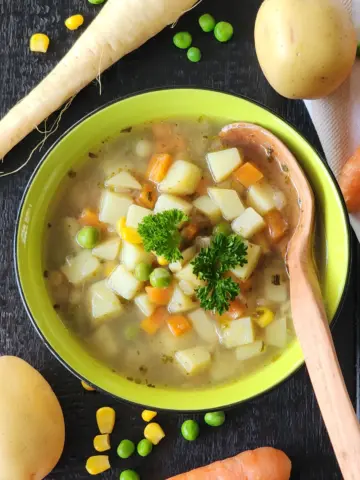
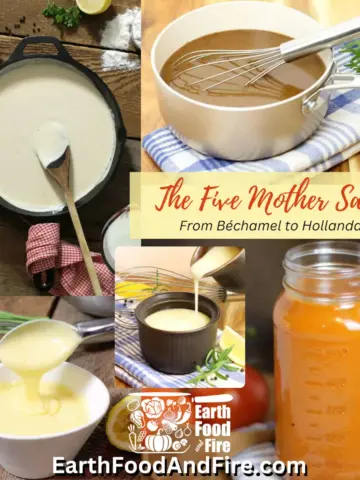
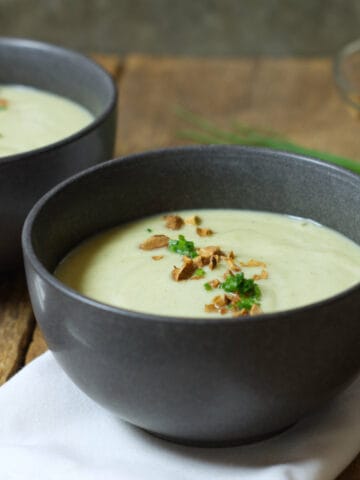
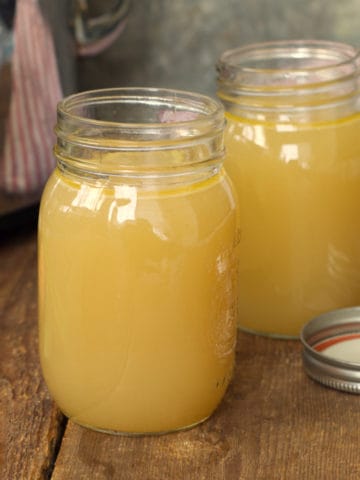
Malcolm Turner
I don't have a garden, so I plant tomato seeds in shopping bags or small wooden crates lined with plastic. I take seeds from tasty tomatoes, put them in water for three days and no longer, changing the water each day, dry nd store till ready to plant.
Chef Markus Mueller
That's awesome Malcolm! I also love saving my own seeds, it's a foolproof way to ensure I always have fresh seeds!
Malcolm Turner
I don't have a garden, so I plant tomato seeds in shopping bags or small wooden crates lined with plastic. I take seeds from tasty tomatoes, put them in water for three days and no longer, changing the water each day, dry and store till ready to plant.
Aleta
This is an excellent post, thanks so much for sharing this recipe, everyone should know how to make a tomato sauce!
abra
Ok, I'm trying to make heads or tails of this. So this would be considered a traditional french tomato sauce, not necessarily an Italian tomato sauce to be used for pasta? I can't imagine celery and chicken stock in my tomato sauce, but I'm an Italian purest when it comes to tomato sauce. What would you use this tomato sauce for? Maybe as a sauce for veggies?
Markus Mueller
This recipe is considered a basic or leading tomato sauce in French Cuisine. Various regions in the world would have their own variations on tomato sauce, depending on ingredients avaliable culture etc. These 5 mother sauces I am covering stem from French Cuisine and are ment to be used as a base for other dishes. You could very easily use this sauce as a base for other pasta sauces (though I can see how an Italan may disagree!) from which you can create other flavour combos. I've used this sauce in Spanish recipes, and even German dishes that call for tomato sauce. It is not by any means an Italian sauce though. Hope this helps!
Christine
I need an immersion blender so I can make this tomato sauce!
Markus Mueller
Haha, while in immersion blender works great, any kind of blender will do. I have even used a nutri-bullet and pureed the sauce in batches! You only need to watch out, pureeing hot liquids causes them to expand. Don't want the blender to explode!
Sasha @ Eat Love Eat
I love making recipes from scratch using ingredients grown in my own garden! It's such a wonderful feeling. This tomato sauce looks delicious!
Markus Mueller
Thanks Sasha!I am so looking forward to getting my garden up and running so I can stock the freezer for next winter!
Erin
I'm always looking for a great sauce recipe. And tomatoes are actually something I can grow!
Markus Mueller
Awesome! This recipe is a great way to preserve your tomato harvest!
Dana
I just left you a super lengthy comment on your FB post about this, but I felt like dropping a comment here too! Great post. I truly can't wait to move to a house with a yard one day (we live in a condo unit right now and have a yard, technically, but not much space). Breaking the ground and growing a vegetable garden is my dream, and to be able to use the fruit of your labor in your food must be the greatest feeling. No matter what though, I always have to add a bit of baking soda to reduce the acidity. I love a smooth sauce, and it's funny because I used to always ask Italians I knew how they reduced acidity, and they'd suggest adding sugar, or cooking a carrot in the sauce. None of those things *ever* worked for me. Finally, I added baking soda one day (because SCIENCE!) and it worked like a charm. The bonus: you get to watch your sauce fizz and foam for a few moments while the acidity is pulled out. Haha.
Anyway, super excited about this series. Can't wait to see more!
Markus Mueller
Baking Soda eh?! That's genius! As a cook, I was always taught to add sugar to the sauce (like you mentioned), but you're right it doesn't actually neutralize the acid, just masks it. I would have never thought of it, I'll be giving it a shot for sure, since my wife has issues with the acid in tomatos. I'll let you know how it goes, thanks for the tip!
Dana
Definitely let me know! I hope it works out. I usually add a tsp, let it do it's fizzy thing, and taste it about 20 mins later. If it still needs a bit of tonight down, I add another tsp. Don't bother tasting it right after adding the baking soda though — it tastes weird. It needs to settle 🙂 Keep me posted!
Annika
Nice recipe, Markus. Do you add the tomato paste to thicken it up? And BTW, I can't live without my immersion blender!
Markus Mueller
I generally add the tomato paste at the start of the cooking process to add some tomato flavour. Towards the end of cooking you could add some tomato paste to help thicken it though you would probably need quite abit. Yoy may be better of reducing the sauce by simmering go thicken it. Alternativly you could thicken the sauce with a roux. I'll be covering roux in next weeka recipe!
Charlotte
I love homemade tomato sauce, especially the versatile kind. Thanks for sharing!
Markus Mueller
It's great! I love making a garlic and chilli variation!